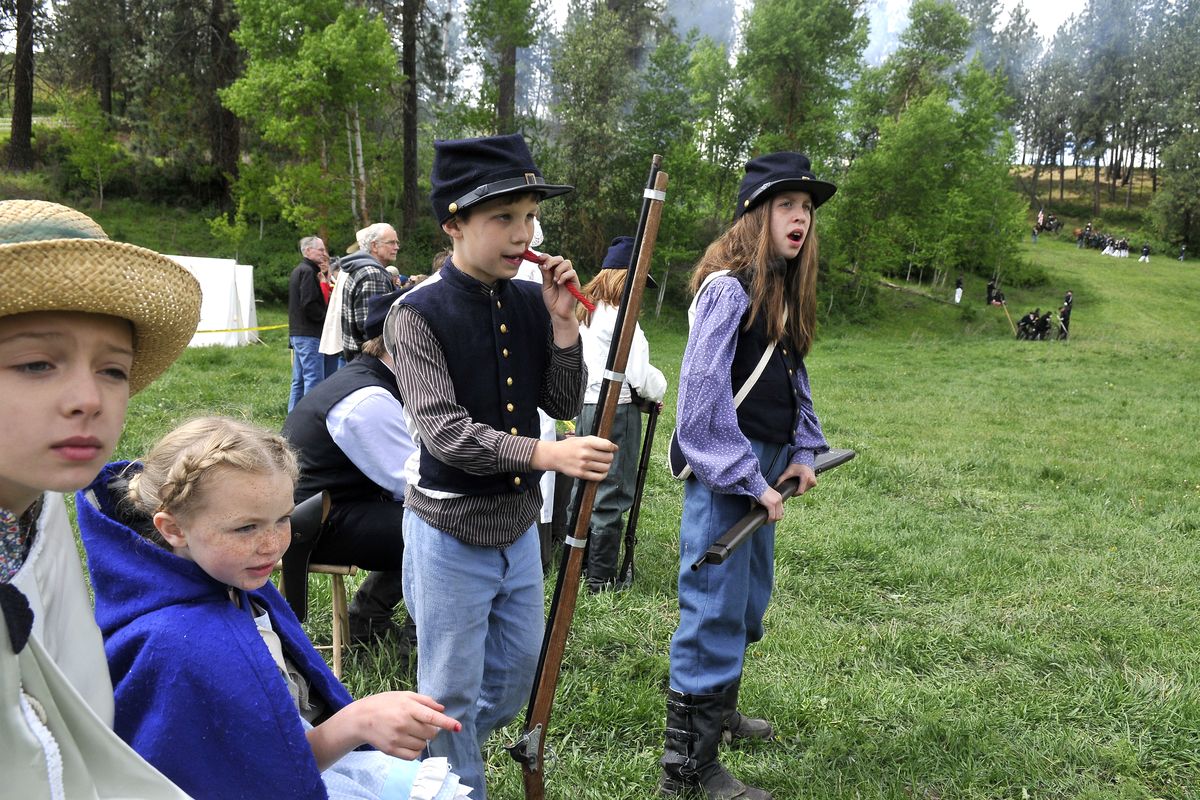Thousands converge at farm for Civil War re-enactment

About 450 people from around the Northwest re-enacted the Battle at Gettysburg over Memorial Day weekend.
And about 4,000 people came to Medical Lake’s Deep Creek Farm to watch it, said event coordinator Bryan Tafoya of the Washington Civil War Association.
This year’s battle scenarios were the Battle of Little Round Top and the Battle of Culp’s Hill, Tafoya said. There were also many living history exhibitions, featuring everything from daily life and weaponry to an artist sketching, but the battlefield was the central focus. The re-enactors arrived, set up their encampments and awakened the countryside with sounds of cannons, rifles, drums, bagpipes and rebel yells.
Among the re-enactors were eight members of the Sisco family: Sonja and Jonathan Sisco, their four children and Sonja’s parents, Grandall and Kathie Gustafson. Abbie and Isaac Sisco were the youngest in the main battlefield events. Isaac, 15, fired cannons for the Union’s 1st Michigan Light Artillery Unit.
Isaac has been collecting Civil War gear since he was about 5 years old and was the first in his family who wanted to become a re-enactor.
“When we finally joined,” he said, “I started out with infantry on the Confederate side. I ended up sticking with artillery because I thought it was more fun to make one big boom.”
Over the entire weekend, the cannons fired some 180 rounds – many big booms. Isaac’s focus during the battle was: “to kick some Confederate butt and do my job quickly.” That meant a 12-second reload, which he proudly described using artillery jargon: “Shoot; then ‘worm it’ to get the tin foil out; ‘mop it’ to extinguish the embers; put the ‘rammer on the muzzle’ and the round in the barrel; ‘ram it home’ into the chamber; ‘prick-n-prime’; lastly, ‘ready to fire.’ ”
Abbie, 13, rode in the Confederate Cavalry and had some challenges over the weekend: Her horse didn’t like the loud cannon and was unexpectedly fond of another horse. However, considering it was her first time with her horse, Abbie said, “She did so awesome!” At a horse training practice weeks before the event, her flag got caught in a tree, which startled her horse; she knew how to recover by dropping the flag to calm the horse. However, during one battle when another Cavalry member was flag-bearer, Abbie kept saying, “Watch the tree! Watch the tree!” and, with a sigh, later added, “She did not hit the tree.”
Cavalry Unit Commander Bob Davisson said Abbie had to achieve a cavalry level two battle certification to participate. “Level two involves riding the horse up to infantry, turning, shooting and getting shot at,” he said. “We ride military style, based on a military manual to train cavalry – it takes your horsemanship to a new level.” He conducts monthly drills with the cavalry, including desensitizing the horses to guns and practicing riding as a group.
The two younger Sisco siblings – Luke, 8, and Chloe, 11 – were part of the Union’s Dashaway Club for ages 12 and younger. After the battle event was over and cleared, Capt. Stephen Howard led about a dozen kids onto the field, including interested young spectators, for mini-skirmishes and spy missions. Luke said, “I mostly like getting shot and falling down.”
Jonathan and Sonja Sisco dressed in period clothing and had a well-equipped tent, including furnishings made by Sonja Sisco’s father, Grandall Gustafson. Gustafson even crafted a replica of Gen. Robert E. Lee’s bed. Her mother, Kathie, collected quilts and made clothes. Sonja Sisco said, “My dad has always been in love with history, especially the Civil War. We started coming as spectators when Isaac was 5.”
Sonja Sisco is a registered nurse, and her interest started with the medical unit. The medical tent displayed tools and taught those gathered about the realities of death, disease and treating injuries with rudimentary medical care of the time.
Jonathan Sisco stopped some young recruits after a skirmish to tell them about the real battle years ago, “when they died, it was a miserable death.” Grandall Gustafson said, “The more I read about the Civil War, the more I wonder how our nation even survived it.”
There were some 620,000 killed in the Civil War, with about 51,000 casualties in Gettysburg; they were remembered with the sound of taps and a memorial wreath as the battlefield scene settled and came to a close.